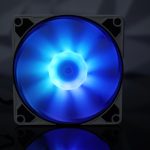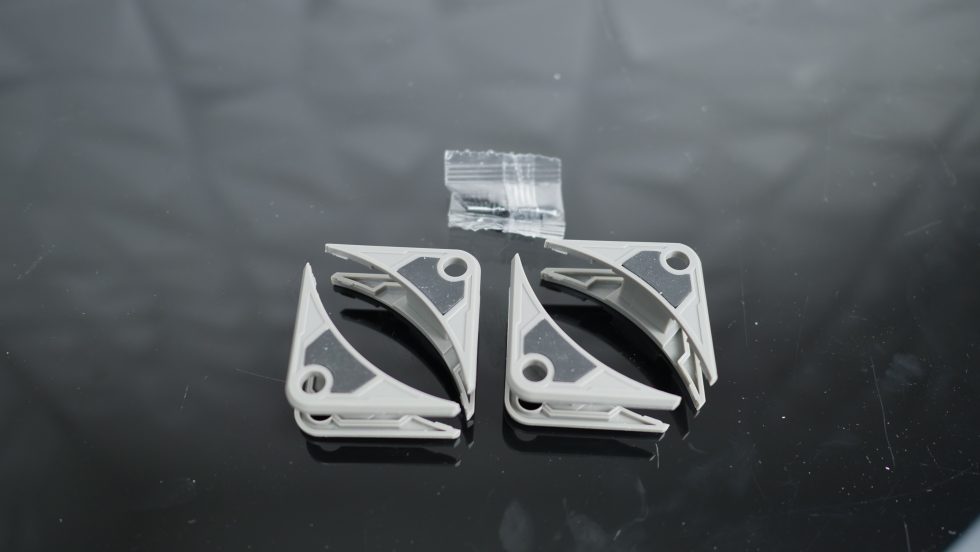Since readers explicitly asked for the Sharkoon Silent Storm 120 mm ARGB case fan and we recently reviewed it, we have now also taken a closer look at the equally expensive 140 mm model. With street prices of also under 11 Euros, you get an ARGB case fan in 140 mm that could not only convince in the test, but is also easy on the wallet. Of course, you have to accept some minor compromises at this price, but the overall package is almost unbeatable. There was even a big surprise, but more on that in a moment. Today’s test will clarify where it is not quite enough to be the high-flyer of all classes due to the price, and what you still get for the low price.
For currently just over 10 Euros, this ARGB fan is a highly interesting offer from the lower price segment and a 3-pack is also said to be in planning. As with the 120 mm model, you need a separate hub for the fan and ARGB because the two ports unfortunately cannot be cascaded (“daisy chain”). We have already asked Sharkoon about this and they promised to include this kind of simplified functionality later on. No matter, suitable hubs are available at Axxxxx for little money.
The new fan is at least exactly within the norm with its 25 mm thickness, which of course makes it more comparable in the end, especially since the rest of the design also tends to follow current trends and does not reveal any daring design stunts at first glance. On the contrary, everything looks as expected and usual, but we already know that from the 120.
Included is the fan along with screws and four interchangeable corners, which I’ll get to in a moment. The connection is made as usual via a 4-pin PWM connector and the normal digital 5V RGB connector. So please don’t force the 12V RGB of older motherboards, it will definitely go wrong. The cable herding of the two ribbon cables is also solved analogously to most other fans and thus doesn’t pose an obstacle.
One relies, as already with the smaller model, on a quite useful seeming hydro-dynamic plain bearing, which allowed amazing things like speeds of far below 100 rpm with DC control! More is really not possible at this price and we have seen much worse for much more money. The measurements later will show that the bearing can not only keep up.
The rotor as a counterpart to the black stator is a translucent block with a total of nine rotor blades, as well as slightly beveled edges and corners. The translucent fan blades and the RGB spacing in the hub with a total of 9 addressable LEDs as well as the omission of an RGB outer ring preserve the original rotor diameter, which should naturally also benefit the performance. Everything is supported by a black, plain frame that does not hide any secrets visually at first glance. The PWM-controlled fan manages a measured speed range of about 440 to just over 1400 rpm without fan stop in PWM mode. Thus, the fan does not go off during PWM control, but this does not bother due to the only minimal noise. But DC goes even better, as we will see in a moment.
The decoupling with the laterally inserted rubber corners is well solved, since it does not twist with the screw tightened and these corners can also be varied in color. By the way, the gap dimensions and surface finish are good. Better, than you would expect from the price
The power consumption is pleasantly low at full speed with 2.64 watts for the fan (without ARGB). But I’ll get to all the details in a moment, because especially DC-controlled, these fans are highly interesting.
| Form factor | 140 mm |
| Strength | 25 mm |
| PWM | Yes |
| RGB | ARGB (hub) |
| Decoupled | Yes |
| Color Frame | Black |
| Accent color | White |
| Color rotor | Translucent |
| Weight in g | 168 |
| min. speed | 400 rpm (measured 440 rpm without fan stop) |
| max. speed | 1400 rpm |
| Volume flow m3/h | 121.9 |
| Flow rate CFM | 71.74 |
| static pressure mmH2O | 1.47 |
| Sound pressure dBA | 34.7 dBA |
| Life Time hrs | 50.000 |
On the next page you will first see how and what we test and why. Understanding the details is incredibly important in order to be able to objectively classify the results later. The differences between many models are more in the details and the best fan for all situations can hardly exist. There is a certain optimum in every situation and, of course, good all-rounders. But they usually have their price. However, if you are planning very specifically with 60 mm radiators, for example, you might be able to save money by choosing the best model for your intended use, which might not perform so well as a case fan. And vice versa, of course.
mn_SilentStorm_140_PWM_int_01














































45 Antworten
Kommentar
Lade neue Kommentare
Veteran
Urgestein
Mitglied
Veteran
Urgestein
Veteran
Veteran
Mitglied
Urgestein
1
Veteran
Urgestein
Urgestein
Urgestein
Urgestein
Mitglied
Alle Kommentare lesen unter igor´sLAB Community →